Air Pollution in the Port City of Lithuania: Characteristics of the Distribution of Nitrogen Dioxide and Solid Particles When Assessing the Demographic Distribution of the Population
Abstract
:1. Introduction
2. Materials and Methods
2.1. Study Area
2.2. Data and Methods
3. Results
3.1. Interaction of NO2: Seasonal Dynamics and Spatial Distribution
3.2. Spatial Distribution of Particulate Matter
3.3. The Impact of Transport on Air Pollution in the Urban Area
3.4. Assessing Demographic and Air Pollution Distribution
- -
- The highest population density areas are marked in dark red, indicating more than 2800 people per grid cell. The population tends to be denser near main roads, indicating the importance of transport accessibility. This is typical in urban planning, where areas with better access to infrastructure attract more residents. We can see that the population is concentrated in the central and southern parts of the city, with significant clusters along the main roads and coastal areas. Very similar tendencies were found in other coastal urban areas. For instance, on coastal urban areas in Portugal, was found that population densities are higher near the coast and major transport routes due to economic activities and better accessibility [28].
- -
- The elderly population shows higher density in the central areas but is more evenly distributed across the city compared to children. Research indicates that older adults often prefer living in central urban areas due to better access to healthcare services, social support, and public transportation [29]. Additionally, the built environment in central areas is usually more conducive to their needs [29]. This trend also can be influenced by historical factors. During the Soviet Union period, urban expansion typically radiated from the center. Initial residents settled close to the city center, and as the city expanded, newer areas developed where younger families moved in (TrueLithuania [30]). Consequently, many older adults who originally settled near the center remain there, while the outskirts of the city have become more attractive to younger families.
4. Conclusions and Discussion
Author Contributions
Funding
Institutional Review Board Statement
Informed Consent Statement
Data Availability Statement
Acknowledgments
Conflicts of Interest
References
- Johansson, M.; Pettersson, P. Population Dynamics in Coastal Urban Areas: The Case of Gothenburg. Urban Stud. 2020, 57, 834–852. [Google Scholar]
- Eckhardt, S.; Stohl, A.; Wernli, H.; James, P.; Forster, C.; Spichtinger, N. A 15-year climatology of warm conveyor belts. J. Clim. 2003, 17, 218–237. [Google Scholar] [CrossRef]
- Zareba, M.; Weglinska, E.; Danek, T. Air pollution seasons in urban moderate climate areas through big data analytics. Sci. Rep. 2024, 14, 3058. [Google Scholar] [CrossRef]
- Pope, C.A.; Dockery, D.W. Health effects of fine particulate air pollution: Lines that connect. J. Air Waste Manag. Assoc. 2006, 56, 709–742. [Google Scholar] [CrossRef]
- Viana, M.; Amato, F.; Simo, R.; Querol, X.; Alastuey, A.; Moreno, T. Chemical tracers of particulate emissions from commercial shipping. Environ. Sci. Technol. 2014, 43, 7470–7476. [Google Scholar] [CrossRef] [PubMed]
- Velders, G.J.M.; Geilenkirchen, G.P.; de Lange, R. Higher than expected NOx emission from trucks may affect attainability of NO2 limit values in the Netherlands. Atmos. Environ. 2011, 45, 3025–3033. [Google Scholar] [CrossRef]
- Cape, J. The Use of Passive Diffusion Tubes for Measuring Concentrations of Nitrogen Dioxide in Air. Crit. Rev. Anal. Chem. 2009, 39, 289–310. [Google Scholar] [CrossRef]
- Heal, M.; Laxen, D.; Marner, B. A Review of Biases in the Measurement of Ambient Nitrogen Dioxide (NO2) by Palmes Passive Diffusion Tube; Scottish Air Quality: Edinburgh, Scotland, 2018. [Google Scholar]
- Jones, A.; Brown, R. Assessment of Air Quality in New York City Using Passive Diffusion Tubes and Particulate Matter Collectors. J. Urban Environ. Stud. 2019, 12, 234–250. [Google Scholar]
- Smith, J.; García, M.; Rodríguez, A.; Pérez, L.; Martínez, F. Urban Air Quality Monitoring Using Passive Samplers and Dust Collectors in Barcelona. Environ. Res. J. 2020, 45, 456–472. [Google Scholar]
- Wang, L.; Wei, X.; Chen, Y.; Liu, Z.; Zhang, L.; Li, Q.; Cao, J. Evaluation of NO2 and PM10 Levels in Beijing Using Diffusion Tubes and Dust Collectors. Int. J. Environ. Sci. Technol. 2018, 17, 88–102. [Google Scholar]
- Amato, F.; Pandolfi, M.; Escrig, A.; Querol, X.; Alastuey, A.; Pey, J.; Perez, N.; Hopke, P.K. Quantifying Road dust resuspension in urban environment by multilinear engine: A comparison with PMF2. Atmos. Environ. 2011, 45, 277–289. [Google Scholar] [CrossRef]
- Chen, R.; Peng, R.D.; Meng, X.; Zhou, Z.; Chen, B.; Kan, H. Seasonal variation in the acute effect of particulate air pollution on mortality in the China Air Pollution and Health Effects Study (CAPES). Sci. Total Environ. 2019, 450, 259–265. [Google Scholar] [CrossRef] [PubMed]
- Tai, A.P.K.; Mickley, L.J.; Jacob, D.J. Effects of CO2 fertilization on maximum summertime ozone in the United States. Atmos. Environ. 2010, 44, 3423–3430. [Google Scholar]
- Vautard, R.; Beekmann, M.; Desplat, J.; Hodzic, A.; Morel, S. Air quality in Europe during the summer of 2003 as a prototype of air quality in a warmer climate. Comptes Rendus Geosci. 2007, 339, 747–763. [Google Scholar] [CrossRef]
- Vautard, R.; Honoré, C.; Beekmann, M.; Rouil, L. Summer air pollution extremes in Europe: How warmer summers will further worsen urban air quality. Environ. Sci. Technol. 2007, 41, 8242–8248. [Google Scholar]
- Santos, G.; Ferreira, F.; Tente, H.; Alves, C. Air quality and the impact of different PM sources in Lisbon, Portugal. Atmos. Environ. 2018, 178, 168–182. [Google Scholar]
- Vardoulakis, S.; Fisher, B.E.; Pericleous, K.; Gonzalez-Flesca, N. Modelling air quality in street canyons: A review. Atmos. Environ. 2003, 37, 155–182. [Google Scholar] [CrossRef]
- Atkinson, R.; Baulch, D.L.; Cox, R.A.; Hampson, R.F.; Kerr, J.A.; Troe, J. Evaluated kinetic and photochemical data for atmospheric chemistry: Supplement VI—IUPAC Subcommittee on Gas Kinetic Data Evaluation for Atmospheric Chemistry. J. Phys. Chem. Ref. Data 1999, 28, 191–393. [Google Scholar] [CrossRef]
- Harrison, R.M.; Yin, J. Particulate matter in the atmosphere: Which particle properties are important for its effects on health? Sci. Total Environ. 2000, 249, 85–101. [Google Scholar] [CrossRef]
- Marshall, J.D.; Nethery, E.; Brauer, M. Within-urban variability in ambient air pollution: Comparison of estimation methods. Atmos. Environ. 2005, 39, 3629–3641. [Google Scholar] [CrossRef]
- Bailey, R.M.; Solomon, P.A. Urban air pollution and road traffic: The impacts and implications. Environ. Res. 2004, 95, 269–280. [Google Scholar]
- Kumar, P.; Morawska, L.; Martani, C.; Biskos, G.; Neophytou, M.; Di Sabatino, S.; Bell, M.; Norford, L.; Britter, R. The rise of low-cost sensing for managing air pollution in cities. Environ. Int. 2014, 75, 199–205. [Google Scholar] [CrossRef]
- Zhang, Y.; Li, L.; Zhao, T.; Li, J.; Dong, H. Air pollution and health effects in China: A review of the epidemiology, exposure, and health effects of fine particulate matter (PM2.5). Environ. Sci. Pollut. Res. 2018, 25, 24067–24097. [Google Scholar]
- Tai, A.P.K.; Mickley, L.J.; Jacob, D.J. Correlations between fine particulate matter (PM2.5) and meteorological variables in the United States: Implications for the sensitivity of PM2.5 to climate change. Atmos. Environ. 2010, 44, 3976–3984. [Google Scholar] [CrossRef]
- Kowalska, M.; Skrzypek, M.; Kowalski, M.; Cyrys, J.; Ewa, N.; Czech, E. The relationship between daily concentration of fine particulate matter in ambient air and exacerbation of respiratory diseases in Silesian agglomeration, Poland. Int. J. Environ. Res. Public Health 2019, 16, 1731. [Google Scholar] [CrossRef]
- Zhou, Y.; Levy, J.I. Factors influencing the spatial extent of mobile source air pollution impacts: A meta-analysis. BMC Public Health 2007, 7, 89. [Google Scholar] [CrossRef]
- Silva, J.; Fonseca, C. Urban Population Distribution in Coastal Areas of Portugal. J. Coast. Res. 2019, 35, 278–290. [Google Scholar]
- Health.gov. (n.d.). Resources for Older Adults. 2024. Available online: https://www.health.gov (accessed on 4 August 2024).
- True Lithuania. (n.d.). Klaipeda. 2024. Available online: http://www.truelithuania.com/klaipeda-248 (accessed on 4 August 2024).
- World Health Organization. Air Quality Guidelines: Particulate Matter, Ozone, Nitrogen Dioxide and Sulfur Dioxide 2005. Available online: https://iris.who.int/bitstream/handle/10665/69477/WHO_SDE_PHE_OEH_06.02_eng.pdf?sequence=1 (accessed on 4 August 2024).
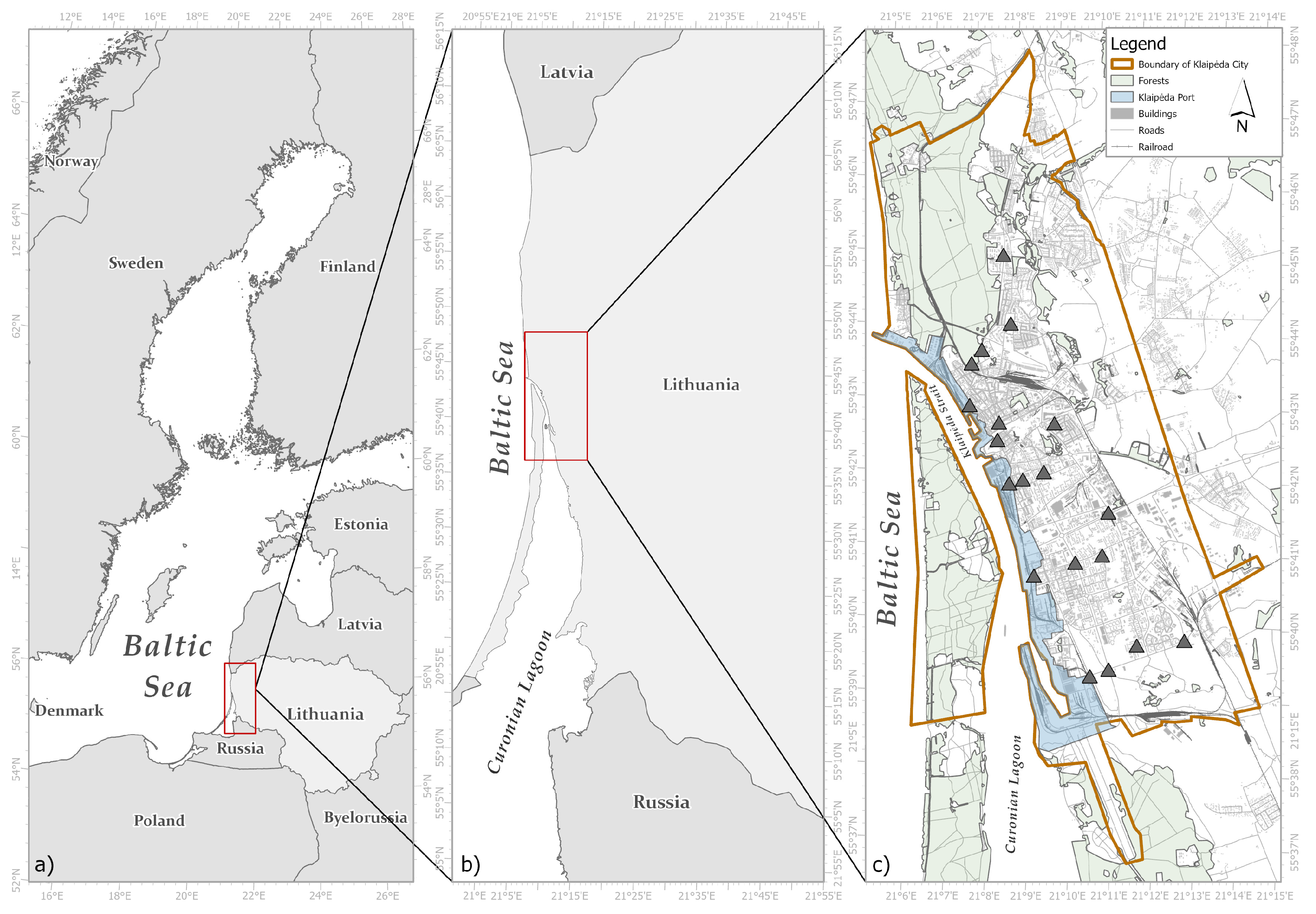


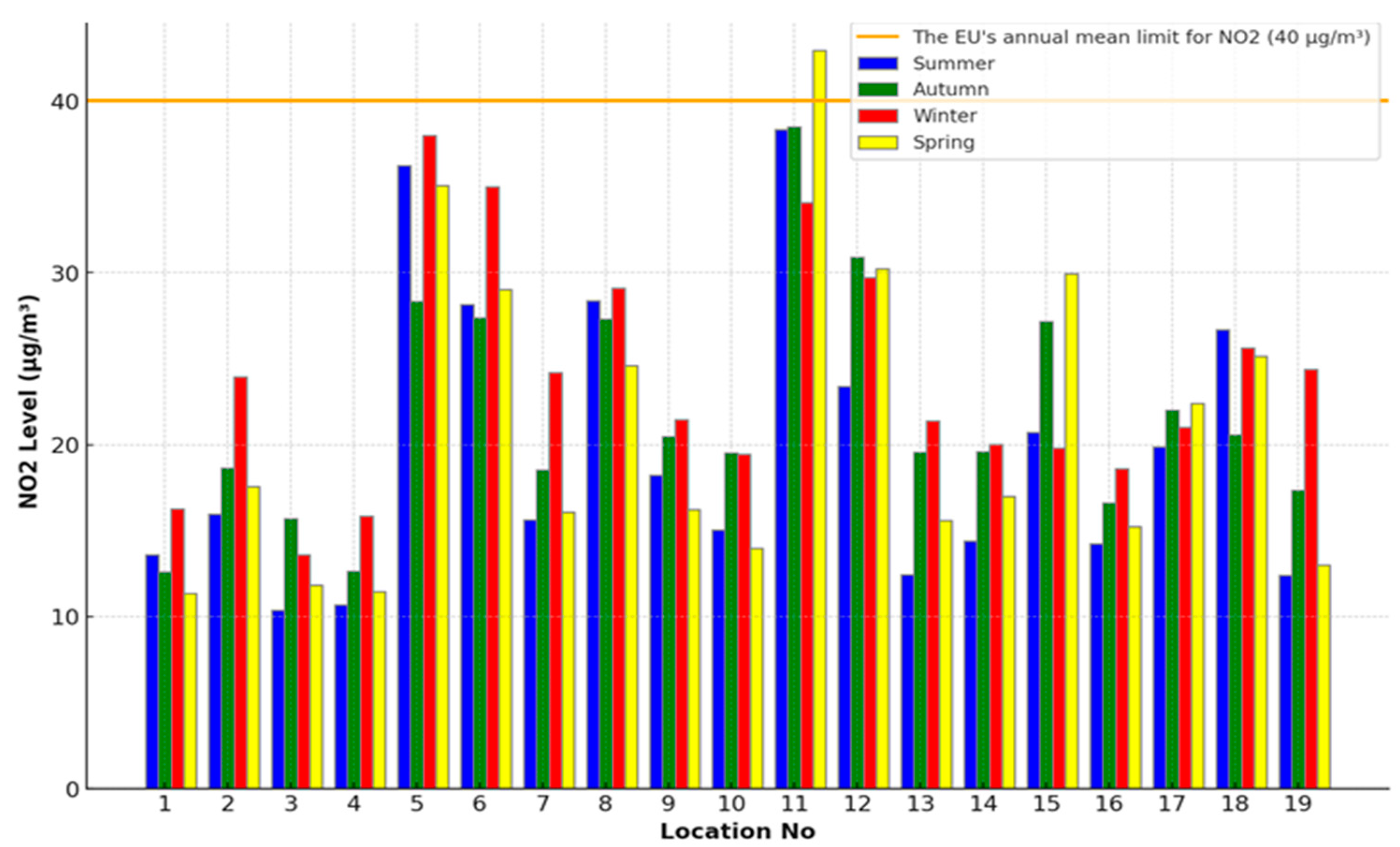

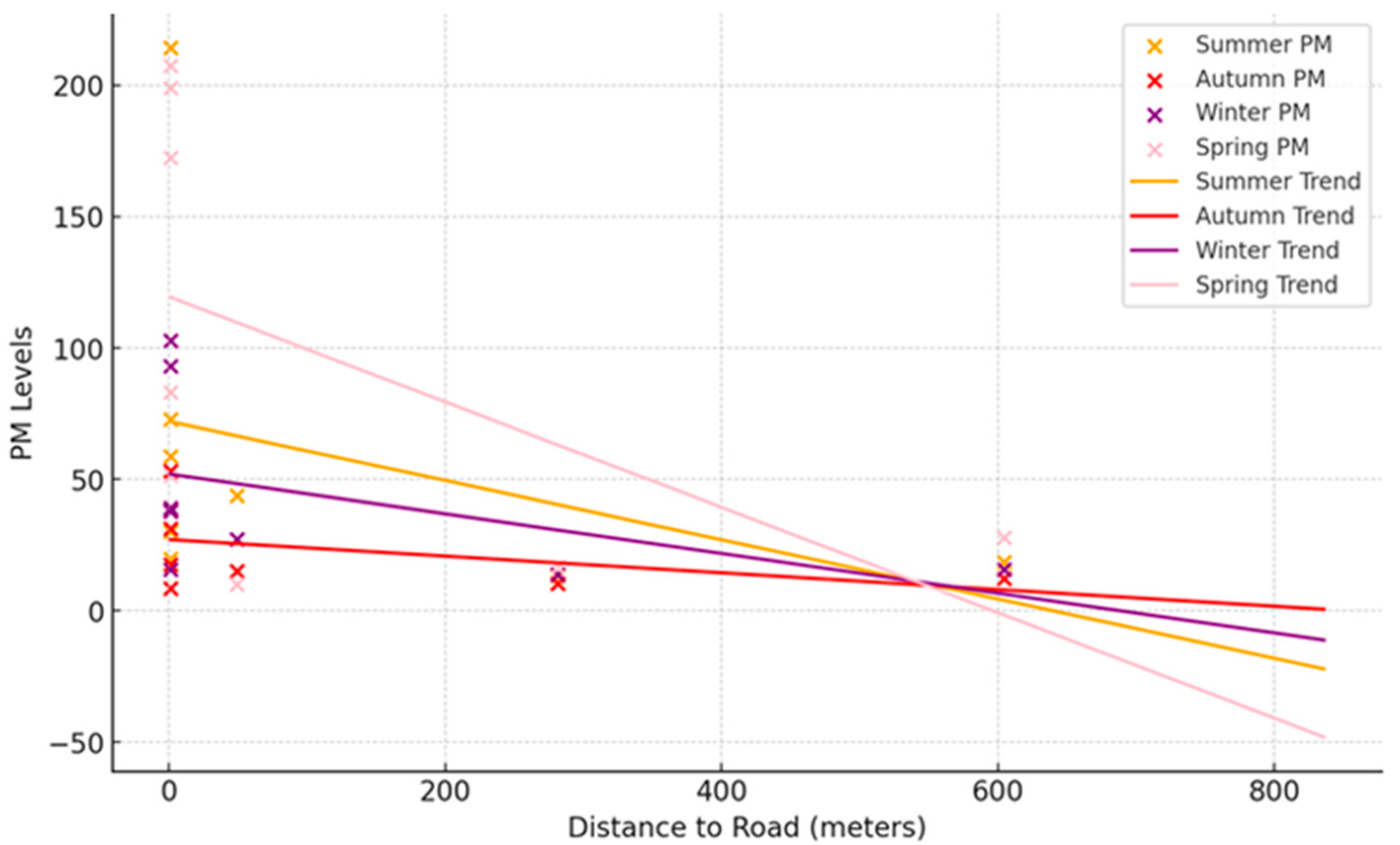

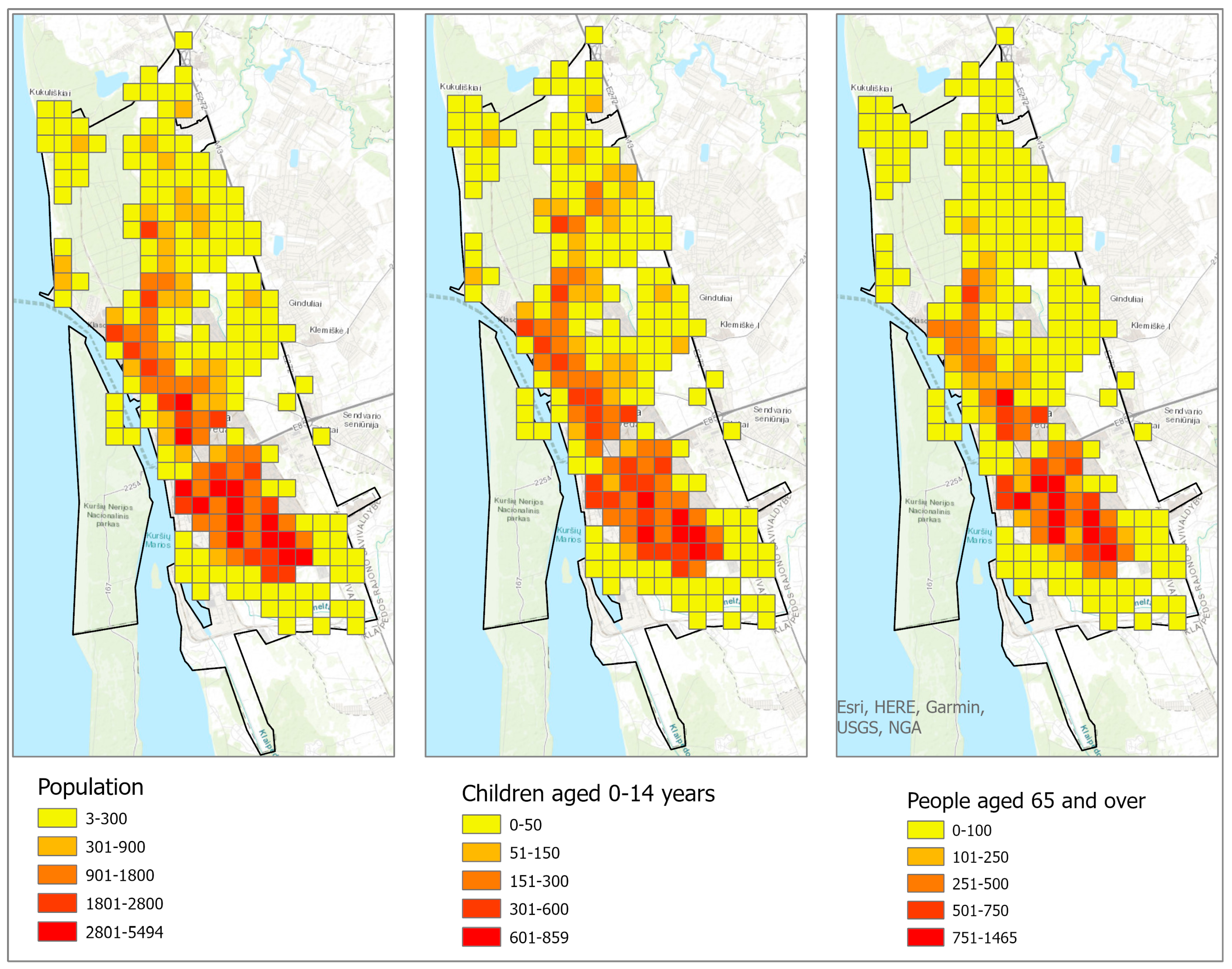
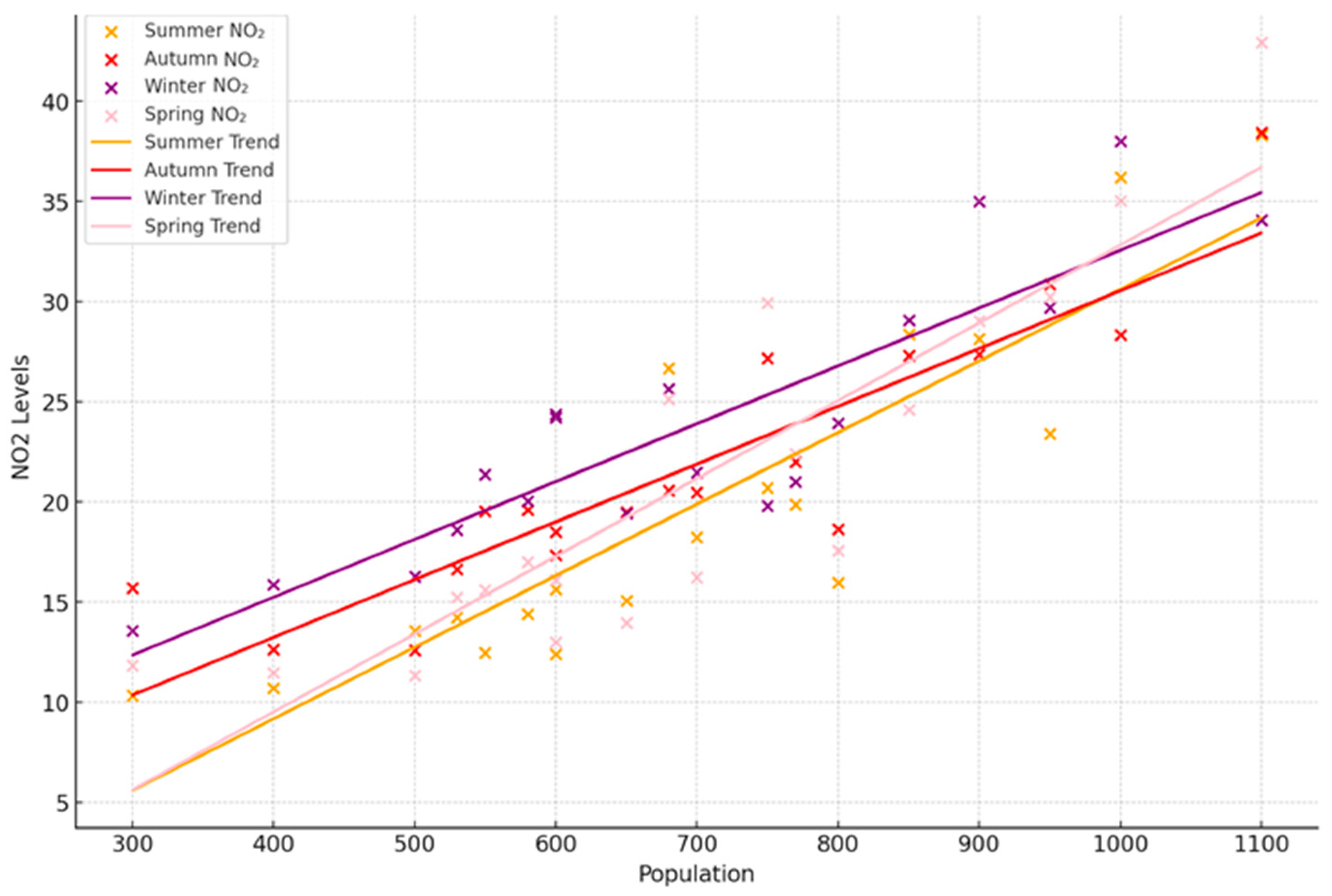
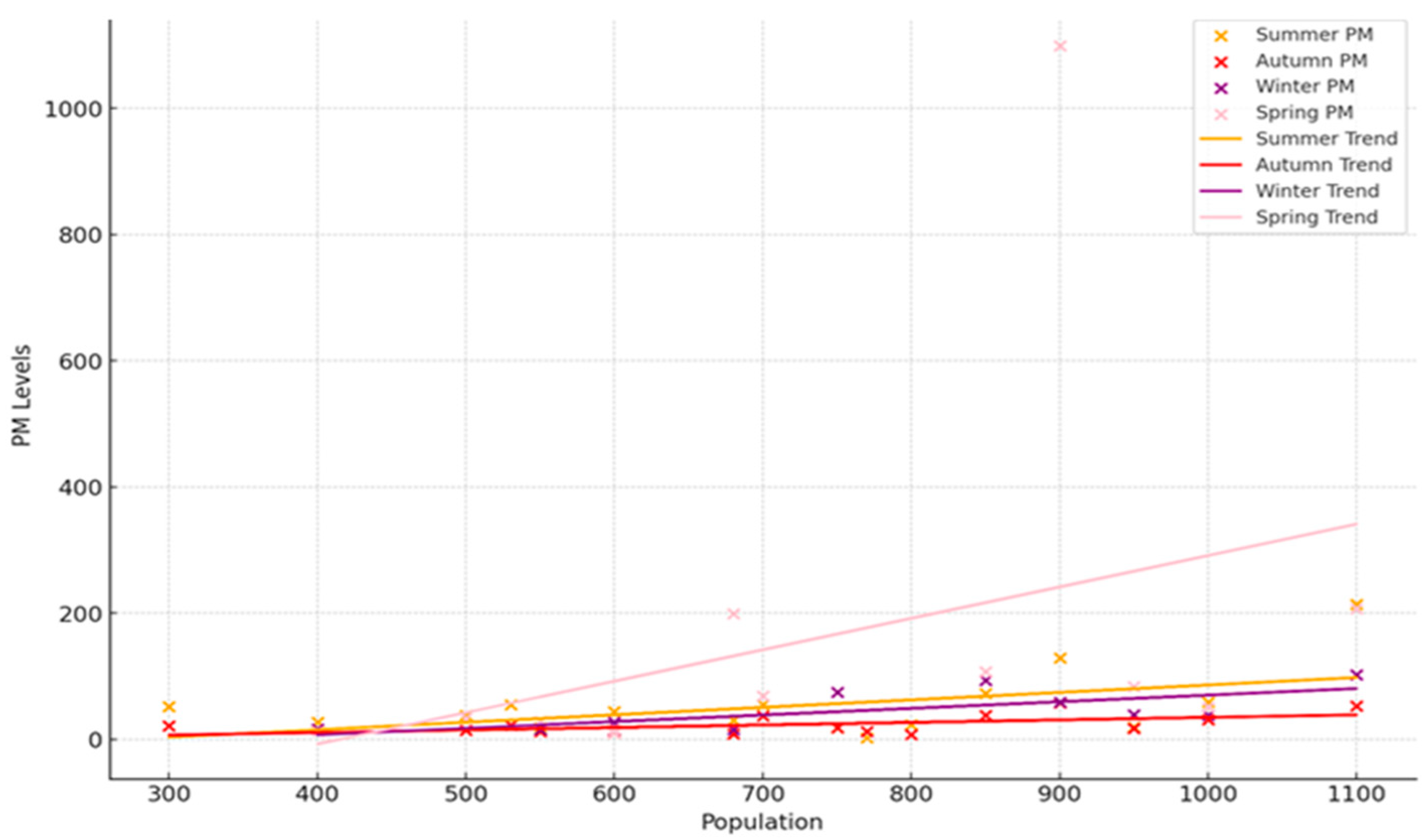
| Location | Summer 22 July 2023/ 5 August 2023 | Autumn 11 November 2023/ 25 November 2023 | Winter 6 January 2024/ 20 January 2024 | Spring 27 April 2024/ 11 May 2024 |
|---|---|---|---|---|
| 1 | 13.58 | 12.6 | 16.27 | 11.34 |
| 2 | 15.96 | 18.65 | 23.94 | 17.57 |
| 3 | 10.35 | 15.69 | 13.58 | 11.83 |
| 4 | 10.71 | 12.64 | 15.87 | 11.47 |
| 5 | 36.22 | 28.33 | 38.01 | 35.05 |
| 6 | 28.15 | 27.39 | 35.01 | 29.04 |
| 7 | 15.64 | 18.51 | 24.2 | 16.09 |
| 8 | 28.37 | 27.32 | 29.09 | 24.61 |
| 9 | 18.24 | 20.48 | 21.47 | 16.23 |
| 10 | 15.06 | 19.5 | 19.45 | 13.98 |
| 11 | 38.32 | 38.46 | 34.06 | 42.94 |
| 12 | 23.4 | 30.88 | 29.72 | 30.25 |
| 13 | 12.46 | 19.54 | 21.38 | 15.6 |
| 14 | 14.39 | 19.59 | 20.04 | 16.99 |
| 15 | 20.71 | 27.16 | 19.81 | 29.94 |
| 16 | 14.25 | 16.63 | 18.6 | 15.24 |
| 17 | 19.86 | 22.01 | 21.02 | 22.41 |
| 18 | 26.67 | 20.57 | 25.64 | 25.15 |
| 19 | 12.42 | 17.35 | 24.38 | 13.0 |
| Mean | 19.11 | 21.69 | 23.34 | 20.37 |
| Median | 16.65 | 19.57 | 21.38 | 16.61 |
| Min | 10.71 | 13.57 | 12.31 | 11.34 |
| Max | 38.32 | 46.36 | 44.10 | 42.94 |
| Percentage of annual pollution | 22.87% | 25.23% | 27.56% | 24.34% |
| Location | Summer 5 July 2023/ 30 August 2023 | Autumn 8 October 2023/ 3 December 2023 | Winter 6 January 2024/ 2 March 2024 | Spring 2 March 2024/ 27 April 2024 |
|---|---|---|---|---|
| 1 | 38.236 | 14.335 | - | 33.245 |
| 2 | 22.961 | 7.795 | - | - |
| 3 | 52.106 | 21.635 | - | - |
| 4 | 27.41 | - | 16.731 | 12.52 |
| 5 | 58.713 | 31.46 | 37.907 | 51.27 |
| 6 | 128.671 | 58.234 | 58.41 | 1099.1 |
| 7 | 43.72 | 15.09 | 27.116 | 10.214 |
| 8 | 72.904 | 38.304 | 92.997 | 107.407 |
| 9 | 55.041 | 37.224 | - | 68.778 |
| 10 | - | - | - | - |
| 11 | 214.256 | 53.32 | 102.678 | 207.327 |
| 12 | 19.623 | 17.588 | 39.013 | 83.233 |
| 13 | 18.37 | 12.332 | 15.818 | 27.877 |
| 14 | - | - | - | - |
| 15 | 18.01 | 18.001 | 74.885 | - |
| 16 | 54.515 | 22.003 | - | - |
| 17 | 2.106 | 12.842 | - | - |
| 18 | 30.124 | 8.535 | 15.589 | 199.133 |
| 19 | 13.317 | 10.475 | 13.933 | 16.6 |
| Mean | 51.18 | 21.96 | 44.73 | 143.08 |
| Median | 2.11 | 3.70 | 13.93 | 10.21 |
| Min | 38.24 | 16.34 | 34.90 | 59.49 |
| Max | 214.26 | 58.23 | 102.68 | 1099.10 |
| NO2 | PM | Distance to the Main Road | p | |
|---|---|---|---|---|
| NO2 | 1.000 | 0.484 | −0.720 | <0.01 |
| PM | 0.484 | 1.000 | −0.399 | <0.01 |
| Distance to the main road (m) | −0.720 | −0.399 | 1.000 | <0.01 |
| Location | Coordinate System WGS | Population Size in Surrounded Area (500 × 500 m Grid) |
|---|---|---|
| 1 | 55.734447, 21.134834 | 500 |
| 2 | 55.728245, 21.123475 | 800 |
| 3 | 55.725872, 21.119513 | 300 |
| 4 | 55.750142, 21.130535 | 400 |
| 5 | 55.710732, 21.132709 | 1000 |
| 6 | 55.715655, 21.119058 | 900 |
| 7 | 55.707931, 21.131572 | 600 |
| 8 | 55.697114, 21.137552 | 850 |
| 9 | 55.699077, 21.142083 | 700 |
| 10 | 55.700985, 21.150571 | 650 |
| 11 | 55.692383, 21.176958 | 1100 |
| 12 | 55.680594, 21.164554 | 950 |
| 13 | 55.682510, 21.175446 | 550 |
| 14 | 55.677348, 21.148155 | 580 |
| 15 | 55.663947, 21.209471 | 750 |
| 16 | 55.662426, 21.190700 | 530 |
| 17 | 55.657118, 21.179168 | 770 |
| 18 | 55.655367, 21.172534 | 680 |
| 19 | 55.711976, 21.153453 | 600 |
| Population | NO2 | PM | |
|---|---|---|---|
| Population | 1.000 | 0.517 | 0.921 |
| NO2 | 0.517 | 1.000 | 0.542 |
| PM | 0.921 | 0.542 | 1.000 |
| Season | Pollutant | Population Coefficient (β1) | Distance Coefficient (β2) | Intercept (β0) | R-Squared |
|---|---|---|---|---|---|
| Summer | NO2 | 0.03 | −0.02 | 10 | 0.75 |
| Autumn | NO2 | 0.04 | −0.015 | 12 | 0.80 |
| Winter | NO2 | 0.05 | −0.01 | 15 | 0.85 |
| Spring | NO2 | 0.035 | −0.018 | 11 | 0.78 |
| Summer | PM | 0.25 | −0.1 | 20 | 0.65 |
| Autumn | PM | 0.3 | −0.09 | 22 | 0.70 |
| Winter | PM | 0.35 | −0.08 | 25 | 0.72 |
| Spring | PM | 0.28 | −0.085 | 21 | 0.68 |
Disclaimer/Publisher’s Note: The statements, opinions and data contained in all publications are solely those of the individual author(s) and contributor(s) and not of MDPI and/or the editor(s). MDPI and/or the editor(s) disclaim responsibility for any injury to people or property resulting from any ideas, methods, instructions or products referred to in the content. |
© 2024 by the authors. Licensee MDPI, Basel, Switzerland. This article is an open access article distributed under the terms and conditions of the Creative Commons Attribution (CC BY) license (https://creativecommons.org/licenses/by/4.0/).
Share and Cite
Andriulė, A.; Vasiliauskienė, E.; Rapalis, P.; Dailidienė, I. Air Pollution in the Port City of Lithuania: Characteristics of the Distribution of Nitrogen Dioxide and Solid Particles When Assessing the Demographic Distribution of the Population. Sustainability 2024, 16, 8413. https://doi.org/10.3390/su16198413
Andriulė A, Vasiliauskienė E, Rapalis P, Dailidienė I. Air Pollution in the Port City of Lithuania: Characteristics of the Distribution of Nitrogen Dioxide and Solid Particles When Assessing the Demographic Distribution of the Population. Sustainability. 2024; 16(19):8413. https://doi.org/10.3390/su16198413
Chicago/Turabian StyleAndriulė, Aistė, Erika Vasiliauskienė, Paulius Rapalis, and Inga Dailidienė. 2024. "Air Pollution in the Port City of Lithuania: Characteristics of the Distribution of Nitrogen Dioxide and Solid Particles When Assessing the Demographic Distribution of the Population" Sustainability 16, no. 19: 8413. https://doi.org/10.3390/su16198413







